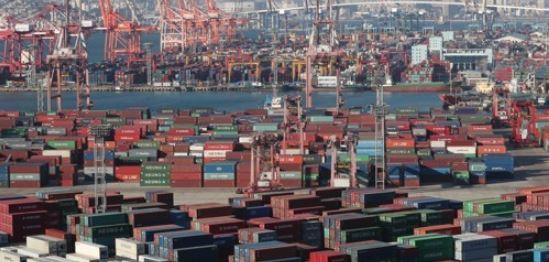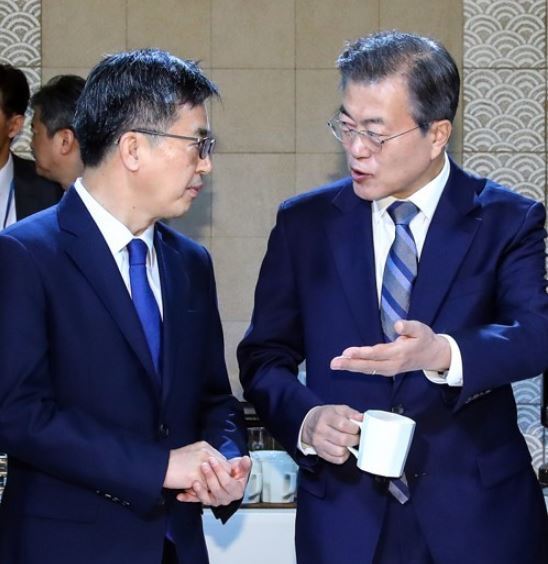SEJONG -- The South Korean economy is on a firm growth trajectory under the Moon Jae-in government, but a dire job market situation, coupled with controversy over the effects of a raft of new economic policies, is posing daunting challenges for the liberal government that took office a year ago.
South Korea's economic growth accelerated last year on the back of robust exports amid a global economic recovery. The nation's economy expanded 3.1 percent in 2017 from a year ago, when it grew 2.8 percent, marking the first time since 2014 that Asia's fourth-largest economy grew by more than 3 percent.
For this year, the economy is widely expected to expand by 3 percent on continued domestic demand recovery and robust exports.
Outbound shipments have been the main pillar of the economy for years, with the total reaching an all-time high of $573.9 billion for 2017, surging from $495.4 billion a year earlier, fueled by an upturn in global demand. The total is the largest annual export tally since the country started compiling such data in 1956.
Imports also jumped 17.7 percent on-year to $478.1 billion last year as the economy posted a combined $1 trillion in trade for the first time in three years.
South Korea chalked up a modest trade surplus by exporting $95.8 billion more than it brought in from abroad last year, up from $89.2 billion in the black reported for 2016.

Backed by robust exports and recovering private spending, per-capita income flirted with the $30,000 level last year. South Korea's per capita GNI, a gauge of the population's purchasing power, reached $29,745, up 7.5 percent from $27,681 tallied in 2016.
South Korea's strong exports and a modest upturn in domestic demand are projected to help the country's per capita gross national income surpass $30,000 for the first time this year.
South Korea would become the third major country in the Asia-Pacific region to achieve the milestone after Japan and Australia. South Korea's per capita GNI has remained under $30,000 since it breached the $20,000 mark for the first time in 2006.
Although a slew of economic data is pointing to a robust economic expansion this year, the country's unemployment is still a source of concern.
Last year, the number of unemployed reached 1.03 million, with the jobless rate for young people aged between 15 and 29 standing at 9.9 percent, the highest since 2000. The number of newly employed came to some 100,000 each in February and March, a sharp drop from 200,000 to 300,000 a month in previous months.
In 2017, the Moon Jae-in government spent a record 18 trillion won ($16.7 billion) to help boost employment. It also jacked up the amount to 19.23 trillion won for the year.
In March, the government proposed the 3.9-trillion-won supplementary budget and a set of measures, including bolder financial and tax incentives, to respond to the high jobless rate among young people. The government submitted the supplementary budget proposal to the National Assembly on April 5.
But the passage of the extra budget bill has been held up as the country's political parties have been at a deadlock over some issues, such as the amendment to the Constitution and an online opinion rigging scandal.
Despite various measures taken in the past, youth unemployment has consistently worsened, due mainly to structural changes in the country's industrial, educational and labor markets. This has led many young people to put off marriage, in turn worsening the very low birthrate.
The government hopes that, with funding support, the nation's youth unemployment will be reduced to below 8 percent by 2021 and up to 220,000 jobs will be newly added over the following year.
"The country's industrial structural change is the main cause of a drop in employment," Lee Keun-tae, a researcher at LG Economic Research Institute, said. "Domestic consumption-boosting policies may help reduce the jobless rate."
Preaching an income-led economic expansion and a reduction of the pay gap between workers, the Moon Jae-in government marked up the minimum wage for all workers by 16.4 percent in 2018 to 7,530 won from 6,470 in 2017 and is planning to increase the wage to 10,000 won by 2020.
The hike in the legal minimum wage is part of the Moon administration's income-led economic growth strategies.
But the number of temp workers has fallen by over 180,000 this year, the largest since the first quarter of 2013, which drew criticism that the minimum wage hike was one of the major factors for the decline in job positions.
Small and medium-sized businesses have expressed concerns over higher labor costs, and business circles claim that the new government policy is adversely affecting the job security of people working in the lowest-paying jobs.
Recent data showed that the number of people newly applying for unemployment benefits reached a record high during the first quarter of this year as some industrial sectors have been slashing workers to reduce costs, with some employers laying off workers they cannot afford to retain.
Some 628,000 people received unemployment benefits, worth 1.49 trillion won in total, during the first three months this year, up 6.9 percent, or 40,000 recipients, from a year earlier, data from the state-run Korea Employment Information Service showed.
The number of recipients is the largest since 2010, when the government began compiling related data.

To complicate matters, the country's statutory maximum working hours is set to be cut to 52 hours a week from the current 68 hours in July, though its implementation will be applied in stages to try to cushion businesses from side effects.
The move comes as many young South Koreans seek to strike a balance between work and life, and it is in line with President Moon's key election pledges to enhance the quality of life for workers and help create jobs down the road.
The reduced working hours, while benefiting some sectors, could be detrimental to others, market watchers say. There have been worries that manufacturing, construction and certain parts of the retail sector could suffer a setback, at least in the short run.
"The reduced working hours could deal a blow to the manufacturing and transportation sectors, where the average working hours are at present over the 52-hour limit," Kim Sung-hee, a professor at Korea University Institute for Research on Labor and Employment, said.
He warned that some companies could move to close their businesses and jobs could be lost unless the pace of the working hours reduction is moderated. (Yonhap)








![[Graphic News] More Koreans say they plan long-distance trips this year](http://res.heraldm.com/phpwas/restmb_idxmake.php?idx=644&simg=/content/image/2024/04/17/20240417050828_0.gif&u=)
![[KH Explains] Hyundai's full hybrid edge to pay off amid slow transition to pure EVs](http://res.heraldm.com/phpwas/restmb_idxmake.php?idx=644&simg=/content/image/2024/04/18/20240418050645_0.jpg&u=20240419100350)








![[KH Explains] Hyundai's full hybrid edge to pay off amid slow transition to pure EVs](http://res.heraldm.com/phpwas/restmb_idxmake.php?idx=652&simg=/content/image/2024/04/18/20240418050645_0.jpg&u=20240419100350)

![[Today’s K-pop] Illit drops debut single remix](http://res.heraldm.com/phpwas/restmb_idxmake.php?idx=642&simg=/content/image/2024/04/19/20240419050612_0.jpg&u=)